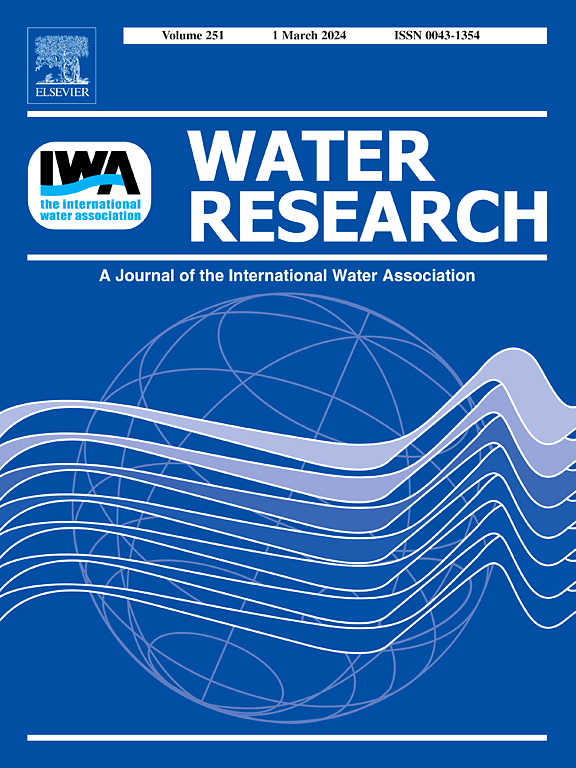Molecular characteristics and plastic additives in dissolved organic matter derived from polystyrene microplastics: Effects of cumulative irradiation and microplastic concentrations
IF 11.4
1区 环境科学与生态学
Q1 ENGINEERING, ENVIRONMENTAL
引用次数: 0
Abstract
Microplastic-derived dissolved organic matter (MP-DOM), released during ultraviolet-induced aging of microplastics (MPs), has emerged as a critical yet underexplored topic regarding the environmental impacts of MPs. However, the effects of irradiation intensity on the release and molecular diversity of MP-DOM, including plastic additives, remain poorly understood. In this study, the photoaging processes of polystyrene MPs (PS-MPs) were simulated under varying cumulative irradiation (irradiation intensity × irradiation duration) and PS-MPs concentrations (1 − 5 g/L). The PS-derived DOM (PS-DOM) was characterized using fluorescence spectroscopy, Fourier transform-ion cyclotron resonance mass spectrometry (FT-ICR MS), and liquid chromatography coupled with high-resolution mass spectrometry (LC-HRMS). After 21 days of irradiation, the amount of leached PS-DOM ranged from 7.76 to 39.40 mg-C/g. Cumulative irradiation significantly accelerated PS-MPs aging and PS-DOM leaching (p < 0.001). Initially, these processes proceeded slowly until the cumulative irradiation exceeded 75 kWh/m2. Beyond this threshold, PS-MPs exhibited substantial size reduction, increased oxidation, and enhanced PS-DOM leaching. FT-ICR MS analysis revealed that PS-DOM contained 30.1 %−31.8 % unique components compared to natural organic matter, with greater degradability at lower PS-MPs concentrations. Furthermore, LC-HRMS identified 13 oxidation products and 25 plastic additives in PS-DOM, with their amounts decreasing as PS-MPs concentrations increased, from 17.05 to 3.24 mg/g and 4.88 to 1.85 mg/g, respectively. Notably, lower PS-MPs concentrations resulted in greater cumulative irradiation per unit mass, intensifying PS-DOM leaching, enhancing degradability, and increasing plastic additives release. This study highlights the environmental implications of per unit cumulative irradiation on MP-DOM leaching and its molecular composition, providing insights into its ecological risks and potential impacts on aquatic systems.


聚苯乙烯微塑料溶解有机物中的分子特征和塑料添加剂:累积辐照和微塑料浓度的影响
微塑料衍生的溶解有机物(MP-DOM)在紫外线诱导的微塑料老化过程中释放,已成为微塑料对环境影响的一个关键但尚未得到充分探讨的话题。然而,辐照强度对MP-DOM(包括塑料添加剂)释放和分子多样性的影响仍知之甚少。本研究模拟了聚苯乙烯MPs (PS-MPs)在不同累积照射(照射强度 × 照射时间)和PS-MPs浓度(1 ~ 5 g/L)下的光老化过程。采用荧光光谱、傅里叶变换-离子回旋共振质谱(FT-ICR MS)和液相色谱-高分辨率质谱(LC-HRMS)对PS-DOM进行了表征。辐照21 d后,PS-DOM的浸出量为7.76 ~ 39.40 mg-C/g。累积辐照显著加速了PS-MPs老化和PS-DOM浸出(p <;0.001)。最初,这些过程进展缓慢,直到累积辐照超过75千瓦时/平方米。超过这个阈值,PS-MPs表现出明显的尺寸减小、氧化增加和PS-DOM浸出增强。FT-ICR MS分析显示,与天然有机物相比,PS-DOM含有30.1% ~ 31.8%的独特成分,在较低的PS-MPs浓度下具有更高的可降解性。LC-HRMS在PS-DOM中鉴定出13种氧化产物和25种塑料添加剂,其含量随PS-MPs浓度的增加而降低,分别从17.05 ~ 3.24 mg/g和4.88 ~ 1.85 mg/g。PS-MPs浓度越低,单位质量累积辐照量越大,PS-DOM浸出加剧,降解性增强,塑料添加剂释放量增加。本研究强调了单位累积辐照对MP-DOM浸出及其分子组成的环境影响,为其生态风险和对水生系统的潜在影响提供了见解。
本文章由计算机程序翻译,如有差异,请以英文原文为准。
求助全文
约1分钟内获得全文
求助全文
来源期刊

Water Research
环境科学-工程:环境
CiteScore
20.80
自引率
9.40%
发文量
1307
审稿时长
38 days
期刊介绍:
Water Research, along with its open access companion journal Water Research X, serves as a platform for publishing original research papers covering various aspects of the science and technology related to the anthropogenic water cycle, water quality, and its management worldwide. The audience targeted by the journal comprises biologists, chemical engineers, chemists, civil engineers, environmental engineers, limnologists, and microbiologists. The scope of the journal include:
•Treatment processes for water and wastewaters (municipal, agricultural, industrial, and on-site treatment), including resource recovery and residuals management;
•Urban hydrology including sewer systems, stormwater management, and green infrastructure;
•Drinking water treatment and distribution;
•Potable and non-potable water reuse;
•Sanitation, public health, and risk assessment;
•Anaerobic digestion, solid and hazardous waste management, including source characterization and the effects and control of leachates and gaseous emissions;
•Contaminants (chemical, microbial, anthropogenic particles such as nanoparticles or microplastics) and related water quality sensing, monitoring, fate, and assessment;
•Anthropogenic impacts on inland, tidal, coastal and urban waters, focusing on surface and ground waters, and point and non-point sources of pollution;
•Environmental restoration, linked to surface water, groundwater and groundwater remediation;
•Analysis of the interfaces between sediments and water, and between water and atmosphere, focusing specifically on anthropogenic impacts;
•Mathematical modelling, systems analysis, machine learning, and beneficial use of big data related to the anthropogenic water cycle;
•Socio-economic, policy, and regulations studies.
 求助内容:
求助内容: 应助结果提醒方式:
应助结果提醒方式:


